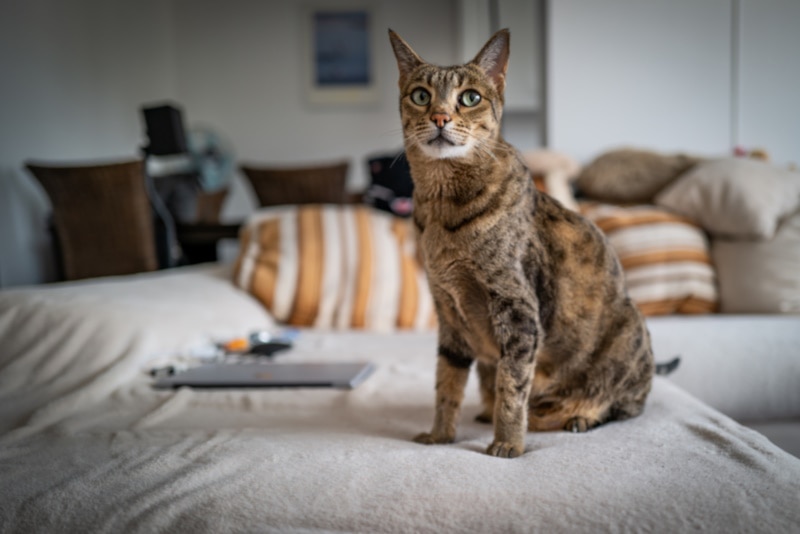How to Keep a Cat Out of a Room: 9 Useful Tips & Tricks
Updated on

Sharing your home with a pet cat doesn’t mean having to give up all your personal space to them. While it’s nice to cuddle together on the couch, maybe you prefer that your kitty not go in your bedroom, bathroom, or study. There’s nothing wrong with keeping a cat out of some spaces in your home! The problem is that doing so is usually easier said than done.
However, keeping your cat out of a room is not impossible. There are a few things you can do to keep that kitty away from spaces you want to keep for yourself. Here are nine tried and true options to consider implementing.
The 9 Tips for Keeping Your Cat Out of the Room
1. Keep the Door Closed
The best way to keep your cat from going into a room is to keep the door closed. However, this is not a foolproof solution because cats are fast and sneaky. They may lie in wait and dart into the space as soon as you open the door to enter yourself. Still, always keeping the door closed will help protect the space from your cat, even if they do end up getting in through the door when it’s opened occasionally.

2. Incorporate an Additional Barrier
Because your cat might try to run through the door when it’s open to get into the room you’re protecting from them, it’s a good idea to incorporate a secondary barrier to rely on as time goes on. Installing a baby gate in the doorway that can stay in place whether the door is open or shut is a great way to keep your cat from darting into the room when you open the door. They’re unlikely to be fast enough to jump over the baby gate in the time it takes you to enter or exit the room and close the door again. Anything that serves as a gate would do, even a piece of old cardboard.
3. Make Other Spaces Exciting
If other spaces in your home are exciting for your cat, there will be less of a chance that they’ll find the room you want to keep them out of. Make sure that cozy bedding, hiding places, toys, scratching posts, and cat condos are readily available in at least one room of your home where they are allowed to hang out. This will keep their focus and interest from being directed at the room they are not supposed to be in.

4. Make the Room Unlikable
While making at least one space in your home extra cozy and interesting for your cat, you should take steps to make the room you want them to stay out of as uncomfortable and unlikable for them as possible—in a humane way, of course. Don’t keep any blankets or pillows out that they could use as a bed when possible (this is hard to do if it’s your bedroom we’re talking about). Don’t allow toys or other cat items, like scratchers, in the room. Keep the room’s curtains closed so there are no opportunities for sunbathing. Minimize objects that could be used as toys.
5. Redirect Attention
Train your cat to stay away from the room you don’t want them in by redirecting their attention anytime they show interest in entering the room. Get their attention by enticing them with a toy, taking them to another room and giving them a treat, or busting out a puzzle toy that you keep stowed away for special occasions. By consistently redirecting your cat’s attention away from the room, they’ll get the point that they shouldn’t be showing that room any attention as time goes on.

6. Utilize Scent Deterrents
There are some scents cats do not enjoy that can be used to deter them from rooms that you don’t want them in. Placing the scents on or near the door of the room will keep your cat from getting too close, and eventually, they won’t want to keep trying to get near the deterrent scents any longer, which will keep them away from the door overall.
Some scents that can be used include:
- Citrus
- Menthol
- Peppermint
- Vinegar
You can spray vinegar or citrus oil on your door or keep a peppermint plant right next to it. The method of implementation doesn’t matter so much as the deterrent scent being there in some way.
7. Make Some Noise
Most cats do not enjoy loud noise, so keeping a radio or television on at a high level or making noise in some other way is likely to make your cat want to head to a quieter area of the home. The noise should keep your kitty from trying to find ways to gain entrance when nobody is supervising. This technique is helpful when you aren’t home so that nobody else hears the noise.

8. Ignore Scratching and Meowing
If your cat scratches or meows at the door to try and get into a room you don’t want them in, ignore them completely. Giving them positive or negative attention can exacerbate the situation because they’ll enjoy getting the attention regardless. Therefore, they might start scratching or meowing at the door merely for attention, with little regard for the room they’re supposed to stay out of.
9. Be Consistent
No matter what tactics you decide to use to keep your cat out of a room you don’t want them in, it is crucial to be consistent. Just because your cat makes their way into the room half the time when you open the door doesn’t mean you should give up and just leave the door open. Keep that door closed as often as possible. The same goes for using deterrent scents. You must make sure that these scents are always on or near the door from day to day.

Conclusion
Cats don’t always like following the rules, so even when they know you don’t want them in a room, they might decide to try to gain entrance whenever possible. Therefore, you may have to utilize multiple techniques to keep your furry family member out of the personal spaces you want to protect from them.
Featured Image Credit: Pierre Aden, Shutterstock











